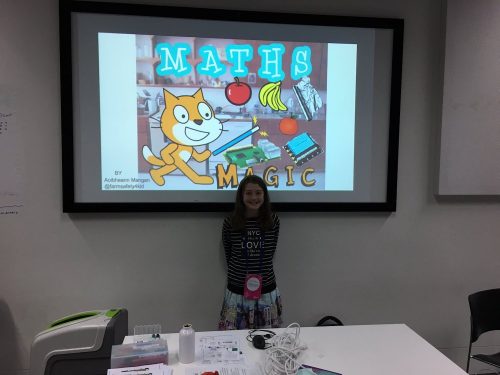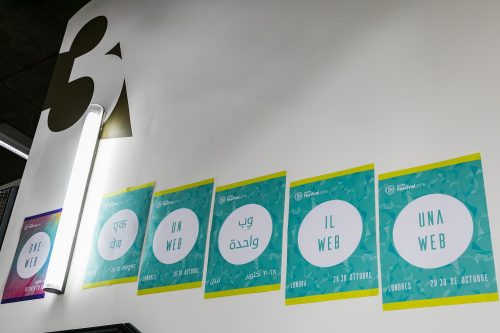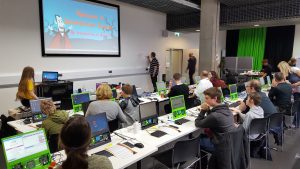Raspberry Pi at MozFest 2016
MozFest, or Mozilla Festival, is an annual celebration of the Mozilla community and the wider open internet movement. People from all over the world gather to explore ways of making the internet a resource that’s open and inclusive to all. This year MozFest was held at Ravensbourne College in London from Friday 28 – Sunday 29 October.
- What will we see through the round windows?
- Not just hard work. Photo by Connor Ballard-Pateman, with kind permission
- Some of the many languages of the Mozilla Festival
Colleagues from the Raspberry Pi Foundation joined members of the community to run workshops across two classrooms in the Youth Zone; this meant more space than last year, bringing more opportunities to engage. Our community volunteers were really enthusiastic and varied in ages. Together we ran workshops ranging from Your Code in Space with Astro Pi, to how to create a burping Jelly Baby, to Physical Computing in Scratch and Hacking Minecraft.

Families and young people at a Raspberry Pi workshop in the Youth Zone at MozFest 2016
One of the workshops I attended was how to create a burping Jelly Baby, run by Bethanie Fentiman (@bfentiman). She led a great session, especially given the technical hitches she encountered during the session: despite all of this, Bethanie and her team of helpers helped me to create a burping Jelly Baby by the end of the workshop. Thank you for all your patience and hard work! You can read Bethanie’s laconic take on MozFest in her blog.
- Bethanie Fentiman helps workshop attendees make Jelly Babies burp
- Jelly Babies. Their time is short
All the workshops were well attended by a mix of families, children and teenagers.
- A child is captivated by a workshop activity. Photo by Connor Ballard-Pateman, with kind permission
- Jonic helps lead a workshop for children and adults. Photo by Connor Ballard-Pateman, with kind permission
Vincent Lee ran a workshop on making a Pi-powered automatic Twitter photo booth. His before and after MozFest blogs have some lovely photos, as well as candid insights into the frantic below-the-surface paddling that happens in order to deliver an event like this one!
- Multi-generational robotics
- A child builds a computer game. Photo by Connor Ballard-Pateman, with kind permission
MozFest 2016 was a great place to find out what you can do with a Raspberry Pi and discover what other members of the Raspberry Pi community have created. People were really impressed at the workshops run by the young volunteers, such as 11-year-old Elise with her workshop on Spooktacular Sounds with Sonic Pi. A massive thank you to them: it’s not easy to teach grown-ups alongside younger people! Elise’s MozFest 2016 blog describes her busy, sociable and exciting weekend.
Aoibheann, who ran Beginners’ Guide to Scratching Maths with Things from the Kitchen, travelled to MozFest from “the middle of nowhere” in the Republic of Ireland (so middle-of-nowhere, she has dial-up internet at home!). Aoibheann’s MozFest blog describes adapting her workshop to accommodate last-minute obstacles and finding that, despite the busy-ness, the Youth Zone was a home from home.

Two very popular workshops at MozFest were LASERS! Create your own jewellery/keyring using a laser cutter and LASERS! Bringing drawings to life! Both were run by Amy Mather, whose enthusiasm for lasers is just one of many things for which she’s become well known in the Pi community. Participants learned how to use Raspberry Pis and Inkscape, an open source design program, to create designs which were then sent to the laser cutter to be made. Amy’s MozFest 2016 blog is full of fantastic photos of laser-cut works-in-progress and finished products.
A huge thank-you to Joseph Thomas for his help with the laser workshop and for running Castles, code and capacitive buttons: Building castles in Minecraft with touch of a button not once, but twice. Joseph’s MozFest 2016 blog explains why, despite ending up with trench foot (really), he’ll still be back in 2017.

A laser cutter brings a workshop participant’s Inkscape design into being at MozFest 2016
Cerys Lock for ran a workshop on Displaying Images and Animations on the Sense HAT – thank you, Cerys! Her pre- and post-MozFest blogs have an excellent photo log and an intriguing credits section.

A massive thank you to the amazing team of 45+ volunteers, from the Pi community and beyond, who helped out over the weekend! Without you, Youth Zone simply would not have happened, let alone been the fantastic, creative space for exploration, discovery and excitement that it was. And particular thanks to Dorine Flies and Andrew Mulholland for their ridiculously hard work as Space Wranglers of Youth Zone this year. Andrew’s blog on MozFest 2016 describes the months of planning and the many long evenings of work that go into the Youth Zone, and he’s drawn together wonderful highlights from the weekend.
Having just joined the Raspberry Pi Foundation, I went to MozFest to get a taste of Raspberry Pi activities before I begin helping to organise other events in the future. I was incredibly impressed with the skill and patience of all the volunteers and their ability to teach me things that seemed very complicated at first. I’m really looking forward to getting to know the community better, as I work with the Raspberry Pi to deliver events that I hope will have just as much energy and passion as MozFest.


















9 comments
karan
Wow!!That is a lot of pi-tops!!
Homer Hazel
It appears as though the calendar runs a bit different in London than it runs in Southern California. Actually I suspect there is a typo in the first paragraph:
This year MozFest was held at Ravensbourne College in London from Friday 28 – Sunday 29 October.
Did you mean Sunday 30 October?
Eric Olson
The pi-topCEED seems a nice design that allows the GPIO to be accessible by removing a panel. The website
https://www.pi-top.com/buy/ceed
seems only to offer the green ones. Where did the black come from? Would it be possible to get blue or yellow?
karan
The pi-topCEED is available in green and grey. When you click “Add to cart”, it gives you a few options, including colour selection.
Isabel
Sounds amazing! You doing any events in Glasgow anytime soon?
Bob
Looks just like a big advert for Pi top to me. Once again Raspberry Pi bias to companies that pay them.
Raspberry Pi Staff Liz Upton
I was going to delete your comment, which is mean-spirited and not based in reality, but I thought I’d let it stand just so I can make something very, very clear.
Pi Top do not pay us a penny. I can’t think of any other companies that we’ve shown “bias” towards in the way you seem to be suggesting who do either: I’m assuming you mean organisations like Adafruit and Pimoroni, or The Pi Hut, or Pi Supply, or Mod My Pi. We do highlight cool stuff those organisations do, though – because it’s cool. Not because we’re paid to. And it’s an offensive accusation: we’re a charity, and we try very hard to do the right thing. We use Pi Top hardware at events like this because right now, for us, it’s the best and most portable solution to the many monitors problem when you’re setting up a big event.
Full disclosure: some organisations have been kind enough to make grants that support our charitable activity. This year we’ve been able to extend our Picademy teacher training to many hundreds more teachers than we would have been able to otherwise because Google offered us venue space and funding to hire trainers. We were able to organise a worldwide weather station project bringing maths, physics, geography and computing to thousands of kids around the world because Oracle helped us to fund that project. I don’t think writing about those projects is emblematic of bias either.
Perhaps you might find a nice cup of tea might help. It certainly calms me down if I feel like writing something mean on the internet about something I’m not very clear about.
Axel Beckert
Are you sure? I was actually surprised that nowhere in the article the Pi-Top is mentioned — despite it can be seen on most of the pictures.
So how should someone advertise something without telling what it is? And no, you can’t call it product placement unless it’s either very well-known product or easily recognizable what brand it is.
I can rather imagine that quite some people were curious where to buy such a nice all-in-one desktop as seen on the pictures and were then disappointed that the article didn’t tell them! Only if you also read the comments (including yours btw.), you get an idea how to find that product on the web.
So your comment (and two others) made those pictures into a product placement — but clearly not the author of that article.
Vincent Lee
Look at it this way, 40 Pitops Ceeds and their power adaptors is a lot easier than counting 40 monitors, 40 kettle cords, 40 Pi Power supplies and 40 Pis.
I had a hard enough time make sure all the equipment was properly accounted for. Currently, alone we have equipment coming from 6 different places. Adding 160 other pieces of equipment would have been a counting nightmare for me.